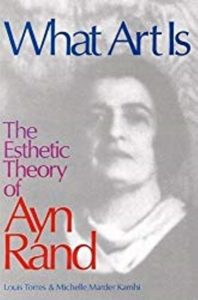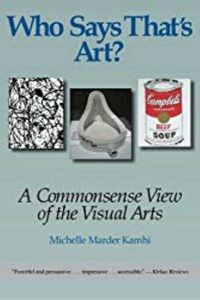Translating deep thinking into common sense
If Art Can Be Anything, Then It Is Nothing

By Vinay Kolhatkar
July 27, 2018
SUBSCRIBE TO SAVVY STREET (It's Free)
 Michelle Marder Kamhi is the co-editor of Aristos, an online review of the arts, and the author of Who Says That’s Art? A Commonsense View of the Visual Arts (Pro Arte Books, 2014). Ms. Kamhi previously co-authored What Art Is: The Esthetic Theory of Ayn Rand (Open Court, 2000)—which dealt with all the major arts and was praised by the American Library Association’s Choice magazine as “a major addition to Rand scholarship” and a “well-documented . . . debunking of twentieth-century art . . . and art theory.”
Michelle Marder Kamhi is the co-editor of Aristos, an online review of the arts, and the author of Who Says That’s Art? A Commonsense View of the Visual Arts (Pro Arte Books, 2014). Ms. Kamhi previously co-authored What Art Is: The Esthetic Theory of Ayn Rand (Open Court, 2000)—which dealt with all the major arts and was praised by the American Library Association’s Choice magazine as “a major addition to Rand scholarship” and a “well-documented . . . debunking of twentieth-century art . . . and art theory.”
Ms. Kamhi earned an M.A. in Art History at Hunter College. Before joining Aristos in 1984, she had been an editor at Columbia University Press, where she worked on titles in its distinguished Records of Civilization series. Among her independent projects was Books Our Children Read, a film documenting a constructive approach to resolving communal conflict over controversial literature in public school classrooms and libraries. Ms. Kamhi is a member of the American Society for Aesthetics, the National Art Education Association, the National Association of Scholars, and the International Association of Art Critics (AICA-USA). Articles by her have appeared in the Wall Street Journal, the Journal of Ayn Rand Studies, and Arts Education Policy Review, among other publications.
Ms. Kamhi (MMK) kindly engaged with Savvy Street’s Chief Editor, Vinay Kolhatkar (VK) on a wide-ranging discussion about art.
VK: The first chapter of your new book Who Says That’s Art, is titled “If Art Can Be Anything, Then It Is Nothing.” Could you elaborate on that?
If art did not possess certain characteristics distinguishing it from other entities (as many in the art establishment now claim), it would have no separate identity.
MMK: It is just another way of expressing Aristotle’s law of identity. Everything that exists has a specific nature. If art did not possess certain characteristics distinguishing it from other entities (as many in the art establishment now claim), it would have no separate identity. The term art would then be meaningless because it would not refer to anything in particular.
VK Is there a simple way to explain the terms “psycho-epistemology” and “sense of life”?
MMK: I’m inclined to regard “psycho-epistemology” as habits of mind, idiosyncratic ways of thinking about the world. And “sense of life” might be thought of as one’s intuitive worldview.
VK: As a scholar of aesthetics, what is the definition of art that you use? Are you able to circumscribe music within that definition? Is photo-shopping to create a meme, art?
MMK: In What Art Is, dealing with all the major “fine” arts (including music), Lou Torres and I proposed revising Rand’s definition (“Art is a selective re-creation of reality according to an artist’s metaphysical value-judgments”) to eliminate her troublesome reference to “metaphysical value-judgments.” My version was “Art is a selective re-creation of reality according to an artist’s fundamental view of life, which includes his deepest values.”
As an auditory art what it [music] properly imitates (albeit in a highly stylized, abstracted manner) is aural experience—in particular, as we noted, vocal expression and the sonic effects of emotionally charged movement.
Our chapter on “Music and Cognition” explains in what respect music is, like the other major arts, essentially mimetic (that is, how it imitates, or selectively re-creates, reality). The mistake that is commonly made regarding music is to expect it to re-create visual experience. As an auditory art what it properly imitates (albeit in a highly stylized, abstracted manner) is aural experience—in particular, as we noted, vocal expression and the sonic effects of emotionally charged movement.
In Who Says That’s Art?, dealing only with the visual arts, I offered the following definition: Visual art is imagery that skillfully represents real or imagined people, places, and things in a form expressive of the maker’s temperament, deeply held values, and view of life.
In that light, photo-shopping to create a meme would clearly not qualify as “(fine) art,” though it might be considered applied art.
VK: Is there scientific support for Rand’s aesthetic theory? If yes, can you discuss what it is?
 MMK: Chapters in both What Art Is and Who Says That’s Art? deal with this question in some depth. For brevity’s sake here, let me point to the most fundamental point of Rand’s theory. It is her understanding of the basic function of art. As I wrote in Who Says That’s Art? she rightly held that:
MMK: Chapters in both What Art Is and Who Says That’s Art? deal with this question in some depth. For brevity’s sake here, let me point to the most fundamental point of Rand’s theory. It is her understanding of the basic function of art. As I wrote in Who Says That’s Art? she rightly held that:
“Humans create art because of a deep psychological need, both cognitive and emotional, to give concrete external form to our inmost ideas and feelings about life and the world around us. As she understood (and is increasingly confirmed by neuroscience), emotions are directly tied to sensory perceptual experience, whereas ideas and values are mental abstractions from that experience. Without external embodiment, such abstractions remain vaguely unreal, detached from our emotional life. Through the arts’ sensory immediacy, we reconnect our thoughts and feelings about things that matter to us, and we are thus made more fully conscious of them. As Rand succinctly put it, ‘Art brings man’s concepts [about such things] to the perceptual level of his consciousness and allows him to grasp them directly, as if they were percepts.’”
VK: Is every mode of art: visual art, fiction, poetry, music, etc. in decline since the Sixties? Or are there little pockets (ballet, for example, or classical music) that have maintained their form against a postmodernist assault? If yes, how so?
All the arts have been affected to some degree by the twentieth-century breakdown of objective standards—which actually began with modernism, well before the postmodernist onslaught of the Sixties.
MMK: As Lou Torres and I documented in What Art Is, all the arts have been affected to some degree by the twentieth-century breakdown of objective standards—which actually began with modernism, well before the postmodernist onslaught of the Sixties. But the performing arts have not been as pervasively affected as the visual arts, for several reasons. To begin with, they require greater investments of personnel and resources to be brought before the public, and if they cannot attract a paying audience, they cannot easily survive.
A telling exception occurs with respect to government-funded work. See “Bias and Inanity in Arts Funding: A Tale of Two Composers,” for example—an article I wrote for Aristos (December 2012).
VK: Is a love of some kind of music intrinsic to virtually every human being? At least I have never met one without a liking for any music, yet there are many people who never visit an art gallery, see a ballet, or read poetry. What could be the reason for this?
MMK: It is probably due to music’s deep and direct connection to emotion, on which much has been written.
VK: In literature, Rand identified a key that separated Romanticism from Naturalism: volition. But is there a way to separate cacophony from music scientifically? Scientific American did once conclude, after rigorous examination, that the melody in pop music has been in decline.
MMK: The very concept of music implies an objective difference between it and mere noise, or cacophony. It refers to a deliberate ordering of sounds in a way that is discernibly distinct from ordinary ambient sounds. It thus points to the absurdity of the avant-garde notion of “noise music” (an absurdity that eluded the academic editors of the Journal of Aesthetics and Art Criticism—who recently published an article devoting serious attention to such work).
The decline of melody in pop music raises a different question, however. While such work can still be discernible as music, it is relatively simplistic in its organization and effects, lacking the depth and breadth of expression found in classical music or even in popular music from the Golden Age of Tin Pan Alley. I’m glad to know that the Scientific American article cites concrete evidence to support that view.
VK: Going back to psycho-epistemology, can incessant exposure to postmodernist art during a person’s formative years change a person for the worse?
MMK: Though it would be difficult to prove, I doubt that incessant exposure to postmodernist work (I wouldn’t call it art) that is typically unintelligible and generally nihilistic in its outlook would be beneficial.
VK: Are the art critics and others who decide on awards for film, literature, and visual art more easily influenced by postmodernist paradigms than, say, those who judge classical music or dance? I mean the equivalent would be to take an untrained dancer jerking to “rap” music and call him a great dancer, or call a cacophony a symphony, but then their game would be up.
MMK: Not necessarily. See the example I cited above in relation to music.
VK: Are we able to define Romantic or Romanticist art? Does such art have a therapeutic value?
 MMK: Unlike many Objectivists, I think Rand’s discussion of Romanticism is the least valuable part of her esthetic theory. I favor any art that expresses positive, life-enhancing or life-affirming values, rather than what Rand narrowly referred to as “Romantic art.” Such values can be found in art from diverse cultural traditions. I’m inclined to think that such work can have a beneficial psychological effect, which might even be indicated by brain scans recording individual responses to such work.
MMK: Unlike many Objectivists, I think Rand’s discussion of Romanticism is the least valuable part of her esthetic theory. I favor any art that expresses positive, life-enhancing or life-affirming values, rather than what Rand narrowly referred to as “Romantic art.” Such values can be found in art from diverse cultural traditions. I’m inclined to think that such work can have a beneficial psychological effect, which might even be indicated by brain scans recording individual responses to such work.
VK: What’s the connection between art and cognition?
MMK: I’ve already given a short answer to that question above in relation to Rand’s view of the basic function of art. For the long answer, see Who Says That’s Art? and What Art Is.
VK: Many thanks for your time, Ms. Kamhi, and we wish you the very best for your varied projects on aesthetics.
MMK: Thanks for your interest and good wishes!







